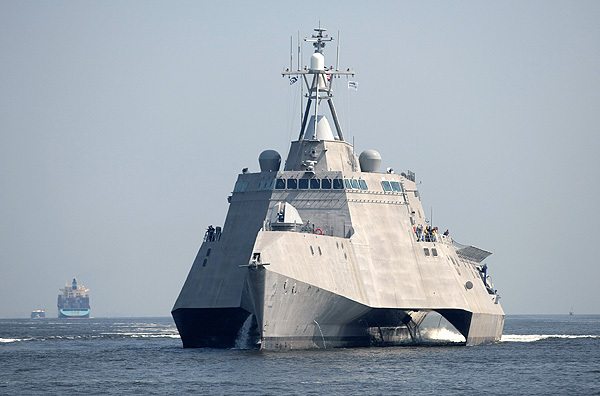In September 2008, the Navy signed a form and took ownership of the first Littoral Combat Ship (LCS), the USS Freedom, from prime contractor Lockheed Martin. According to the Pentagon office of the director of test and evaluation (DOT&E), the LCS “is designed to operate in the shallow waters of the littorals where larger ships cannot maneuver as well.”
The contractor is typically required to provide the government with a “material inspection and receiving report,” or DD 250 form, according to DoD regulation. When the Department of Defense (DoD) accepts delivery of goods or services under contract, it signs the DD250.
As explained in a document on the Defense Contract Management Agency’s website, this form “is a multipurpose report used as: 1) “Acceptance of equipment/data by the Government (i.e. title transferred to the Government),” 2) “The Contractor’s invoice for payment,” 3) “A packing list for shipping and receiving” and 4) “Evidence of Government Quality inspection.”
But just because the government accepts a good or service—for instance, a several hundred million dollar ship—that doesn’t mean the government thinks it’s completely satisfactory. According to the DCMA document:
Situations arise when a product is to be accepted, (i.e. to meet a ship deployment), with known deficiencies (deficiencies may be: missing assets (hardware/software, unperformed tests, etc)) that the Contractor will correct within a specific time frame.
“In these cases,” the document notes, “the DD 250 shall be annotated with the deficiencies: listing the deficiencies, and when/ how the Contractor will make the corrections.”
The USS Freedom was one of these cases, according to this week’s FOIA Friday document, the LCS DD-250 form. When the first LCS was accepted, it had a slew of systems that were not inspected in its first acceptance trial in August 2008. These systems were slated to be assessed a second acceptance trial in 2009.
And deficiencies were found with some of the USS Freedom’s systems at the time of acceptance in 2008. For example, several topside systems (that are exposed to the elements), such as the Dorna Gun Fire Control System and Air Search Radar System. The RAM Guided Missile Launcher had non-compliances associated with it, indicating it might have problems under certain environmental conditions.
It is unclear what the current situation is regarding these non-compliances noted in late 2008, three years ago. POGO will be reaching out to Lockheed and the Navy to find out. The DOT&E annual report for fiscal year 2010 (released early this year) states that the “LCS 1 critical ship control systems essential to support the crew have performed well in testing; however, several systems required for self-defense and mission package support have demonstrated early reliability problems.”
Whatever the case is with the USS Freedom, the government should remain haunted by its experience with the Coast Guard’s Deepwater program. In that program, the Coast Guard accepted delivery of ships built by a team led by a Lockheed Martin-Northrop Grumman partnership. But the Coast Guard accepted ships with a wide array of deficiencies that should not have been accepted. Disclosures by Lockheed engineer and whistleblower Michael DeKort blew open the issue in a YouTube video.
Among the many issues raised by DeKort at a House hearing on the Coast Guard’s Deepwater program, DeKort noted the failure to fix non-compliances and the failure to call out non-compliances in DD 250s.
The Department of Homeland Security Inspector General “states that the Coast Guard did not know the boats were non-compliant until July of 2005, one and a half years after the first 123 was delivered,” DeKort said. “The report also states that none of these problems were fixed, not on any of the delivered boats. That, along with this issue not being called out in the DD-250 acceptance documents, supports my supposition that Lockheed Martin purposefully withheld this information from the Coast Guard.”
POGO also received, through FOIA, a DD 250 cover sheet dated December 2009 for the second LCS, the USS Independence. But, unlike the DD 250 for the USS Freedom, there were no attachments associated with that DD 250 for the USS Independence.
This may be part of the reason why: the Navy, as of the end of last year, had not accepted all of the systems associated with the USS Independence built by a contractor team led by General Dynamics.
“LCS 2 completed part one of Acceptance Trials and deferred several events to a second Acceptance Trial in early 2011,” according to the fiscal year 2010 Pentagon annual test report. “The ship was found to be incomplete; several systems and spaces have not been accepted by the government.”
[Download not found]










